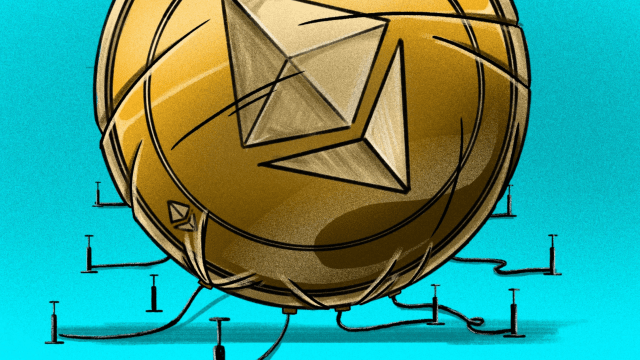NFTs have become an investing phenomenon, with everything from GIFs to sports highlights selling for millions of dollars. But how much of this is hype — and should we be reassured by celebrity endorsements from Logan Paul, Paris Hilton, Lindsay Lohan, Rob Gronkwoski and uh… Taco Bell? Here’s a look at why the NFT market might collapse in the near term.
What are NTFs?
NFTs (“Non-fungible tokens”) use the same blockchain technology that powers cryptocurrencys like Bitcoin, with a key difference: They’re not interchangeable, and each one is unique. If you buy an NFT through a crypto asset marketplace, it’s yours to keep in your digital wallet or put up for sale on the marketplace. When an NFT is sold, all computers on a decentralised network record the transaction on a shared ledger, which, in effect, creates a certification of authenticity that can’t be altered or erased.
[referenced id=”1048872″ url=”https://www.lifehacker.com.au/2021/03/why-is-everyone-investing-in-nfts/” thumb=”https://www.gizmodo.com.au/wp-content/uploads/sites/4/2021/02/27/h8bsv2eda8ygdofqzrw0-300×169.jpg” title=”Why Is Everyone Investing in NFTs?” excerpt=”Non-fungible tokens, or NFTs, have become an overnight investing phenomenon, with $US60 ($77) ($US77 ($99)) million in sales on Tuesday — surpassing total sales for the entirety of 2020. An NFT is a type of cryptographic token used to make digital media unique and therefore collectible, whether that’s a GIF or even…”]
In theory, NFTs solve the problem of how to compensate creators for digital content, either by direct sales or through royalties. Of course, you could easily copy these digital items, but part of the appeal is owning something essentially signed by the artist, like an autographed baseball card.
The market for NFTs encompasses collectible trading cards, sports highlights, art, music, and even virtual assets like property in open-world video games. There’s been a lot of hype and speculation about them of late, with eyebrow-raising stories of sales prices in the millions. Examples include a Nyan Cat meme GIF selling for nearly $US600,000 ($772,680), and Twitter’s CEO Jack Dorsey’s first tweet selling for $US2.5 ($3) million.
Our Spicy Potato Soft Tacos can now live in your hearts, stomachs and digital wallets. https://t.co/IC8b45lmd9 pic.twitter.com/FJUcuwCuyy
— Taco Bell (@tacobell) March 8, 2021
Why the NFT market might already be overinflated
One of the biggest knocks against NFTs is that it’s a market with artificial scarcity, as there’s no limit to how many NFTs you can create — literally any bit of data can be authenticated and sold. As Charlie Lee, creator of Litecoin and an NFT sceptic, explains in a recent Twitter thread:
Unlike NFTs, real world art is not zero cost. It takes effort and time to create a piece. This is effectively Proof of Work. A famous artist like Picasso can only create thousands of pieces of art in his lifetime. This limitation creates scarcity, which helps keep the value high.
NFTs, on the other hand, create artificial scarcity. Because of the near zero cost to create another NFT, the market will eventually be flooded with NFTs from artists trying to cash in on this craze. Supply will overwhelm demand and the prices will eventually crash.
Furthermore, Lee believes that, for many, the true appeal of NFTs is in the certificate of authenticity, which will have limited value in the long run:
The majority of the value of owning a collectible is lost by switching the ownership from the actual collectible to its certificate of authenticity. That’s basically what NBA TopShot NFTs are. They are digital certificates to a short video Moment that anyone can download. It’s true that with NBA TopShot, you can point to an nbatopshot.com URL and be proud to say look it says I own this Moment. This wears off pretty quickly though.
Other concerns
While NFTs offer a certificate of ownership, the creator of an NFT doesn’t have to prove ownership of the original work. NFT marketplaces are already dealing with instances of stolen art and copyright violations. For example, per Yahoo, an artist known as Ashtoshi says a selfie was put up for auction on Rarible, without her consent, for over $US1,051 ($1,353) worth of crypto.
And as Gizmodo points out, NTFs are built on blockchain technology that comes with a tremendous energy cost. Most marketplaces for NFT assets conduct sales through Ethereum, which maintains a ledger of transactions secured through a process called mining, but the process requires a lot of energy. In 2018, Ethereum used more energy than Iceland, according to Bloomberg. The impact to the environment will only be made worse as the NFT market grows.
The bottom line
In many ways, NFTs resemble Initial Cryptocurrency Offerings, or ICOs, a speculative investing fad that fizzled out in 2018, despite a strong start. Similar to NFTs, ICO pricing was initially vastly inflated, and the product was overhyped with celebrity endorsements (DJ Khaled! Steven Seagal!). The initial frenzy didn’t last, and the market shrunk from $US24 ($31) billion to $US5 ($6) billion, according to the Wall Street Journal.
If you’re thinking about buying NFTs, consider whether the hype is sustainable, and only invest an amount you’re comfortable with losing. After all, unless you’re a creator, NFTs don’t provide any cash flow, and the only way you can make money is through more buying and selling — meaning if the market crashes, bragging rights might be all you have.

Leave a Reply
You must be logged in to post a comment.